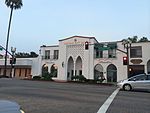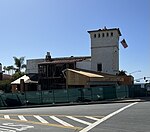San Clemente Pier station

San Clemente Pier station is a passenger train station near the San Clemente Pier in San Clemente, California, United States. The station is lightly used – only four Amtrak Pacific Surfliner trains per day stop at the station (two trains in each direction), while Metrolink's Orange County Line and Inland Empire–Orange County Line only serve the station on Saturdays and Sundays (Metrolink also serves San Clemente station just north of this station daily).San Clemente Pier boarded or detrained a total of 15,017 Amtrak passengers in the 2013 fiscal year, an average of approximately 41 passengers daily, an over 50% increase from the 2012 fiscal year. Of the 74 California stations served by Amtrak, San Clemente Pier was the 54th-busiest in the 2013 fiscal year. In 2020, the ridership at the station dropped 57.4% to a total of 6,707, largely due to complications of the COVID-19 pandemic.The station was formerly a stop of the Santa Fe's San Diegan line.
Excerpt from the Wikipedia article San Clemente Pier station (License: CC BY-SA 3.0, Authors, Images).San Clemente Pier station
San Clemente Beach Trail, San Clemente
Geographical coordinates (GPS) Address Nearby Places Show on map
Geographical coordinates (GPS)
| Latitude | Longitude |
|---|---|
| N 33.419166666667 ° | E -117.61944444444 ° |
Address
San Clemente Beach Trail
San Clemente Beach Trail
92763 San Clemente
California, United States
Open on Google Maps








